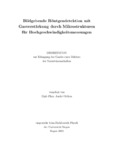Citation link:
https://nbn-resolving.org/urn:nbn:de:hbz:467-670Files in This Item:
| File | Description | Size | Format | |
|---|---|---|---|---|
| orthen.pdf | 15.85 MB | Adobe PDF |  View/Open |
| Dokument Type: | Doctoral Thesis | metadata.dc.title: | Bildgebende Röntgendetektion mit Gasverstärkung durch Mikrostrukturen für Hochgeschwindigkeitsmessungen | Authors: | Orthen, André | Institute: | Fachbereich 7, Physik | Free keywords: | Bildgebender Gasdetektor, Gasverstärkungsmikrostruktur, Hochgeschwindigkeitsmessung | Dewey Decimal Classification: | 530 Physik | GHBS-Clases: | UIGD | Issue Date: | 2004 | Publish Date: | 2005 | Abstract: | Eine Vielzahl biologischer und technischer Anwendungen an Synchrotronstrahlungsquellen erfordert schnelle, bildgebende Rontgendetektoren, die sich durch eine gute Zeit- und Ortsauflosung bei gleichzeitig großer sensitiver Fläche auszeichnen. Aufgrund fehlender kommerziell erhältlicher Systeme für diesen Anwendungsbereich, werden in der vorliegenden Arbeit detaillierte Studien eines neuartigen, gasbasierten Einzelphotonzählers mit Gasverstärkung durch Mikrostrukturen vorgestellt. Diesbezüglich wird die Eignung von MicroCAT- und GEM-Strukturen, ihrer Kombination und Konstellationen von Zweifachund Dreifach-GEMs für den Einsatz in Hochgeschwindigkeitsmessungen, die im Allgemeinen hohe Photonenflüsse erfordern, diskutiert. Da die Hochratenverträglichkeit des Detektors im Wesentlichen durch Raumladungseffekte und durch Totzeit beschränkt ist, konzentrieren sich die Untersuchungen auf die Optimierung des Ladungstransfers und der Signallänge, aber auch auf das Gasverstärkungsverhalten bei unterschiedlichen Gasmischungen und -drücken. Die zweidimensionale Positionsbestimmung eines Ereignisses wird durch ein interpolierendes Auslesekonzept realisiert, das auf resistiver Ladungstrennung basiert und große sensitive Flächen bei gleichzeitig wenigen elektronischen Kanälen ermoglicht. Um von der asynchronen und parallelen Auslesefähigkeit zu profitieren, wird ein neues, speziell an das interpolierende Auslesekonzept angepasstes, elektronisches Datenverarbeitungs- und Auslesesystem entwickelt. Durch die lokal beschränkte Auslese der Orts- und Energieinformationen zeichnet sich dieses System durch eine hohe Ereignisausleserate bei geringer, lokal begrenzter Totzeit aus. Die erfolgreiche Optimierung des hier vorgestellten Detektorsystems für Hochgeschwindigkeitsmessungen führt zu einem flexibel einsetzbaren Werkzeug, das eine Zeitauflosung in der Großenordnung von 100 ns und eine lokale Ratenverträglichkeit von > 10 6 Photonen s −1 in punktformigen Beugungsmaxima bietet. Die globale Ratenverträglichkeit, die direkt proportional zur sensitiven Fläche ist, beträgt mehr als 2 · 10 5 Photonen cm −2 s −1 . Many biological and technical applications at synchrotron radiation facilities require fast X-ray imaging detectors with good temporal and spatial resolution and large sensitive area. Motivated by the absence of commercially available detectors for these purposes, this thesis describes detailed studies of a novel gaseous single photon counter with gas amplification by micro pattern devices. In this respect, the suitability of MicroCAT and GEM micro structures, their combination and constellations of double- and triple-GEM stages is investigated for utilisation in high speed measurements, which usually demand high photon fluxes. Since the high rate capability of the detector is mainly limited by space charge effects and by dead time, the studies are focussed on the optimisation of the charge transfer behaviour and the signal lengths but also on the gas gain performance in different gas mixtures and pressures. The truly two-dimensional determination of the event position is realised by an interpolating readout concept based on resistive charge division, providing a large sensitive area with only a few electronic channels at the same time. To fully exploit the asynchronous and parallel readout capability, a newly developed electronic preprocessing and readout system has specially been adapted to the interpolating readout concept, offering low dead times and a high readout speed owing to the use of a locally confined readout of the spatial and energy information. The optimisation of the detector system, presented here, with respect to high speed measurements successfully leads to a flexible tool providing a time resolution of the order of 100 ns and a rate capability > 10 6 photons s −1 in diffraction peaks. The total rate capability amounts to more than 2 · 10 5 photons cm −2 s −1 and is proportional to the sensitive area of the detector. |
URN: | urn:nbn:de:hbz:467-670 | URI: | https://dspace.ub.uni-siegen.de/handle/ubsi/67 | License: | https://dspace.ub.uni-siegen.de/static/license.txt |
| Appears in Collections: | Hochschulschriften |
This item is protected by original copyright |
Page view(s)
389
checked on Nov 28, 2024
Download(s)
117
checked on Nov 28, 2024
Google ScholarTM
Check
Items in DSpace are protected by copyright, with all rights reserved, unless otherwise indicated.

